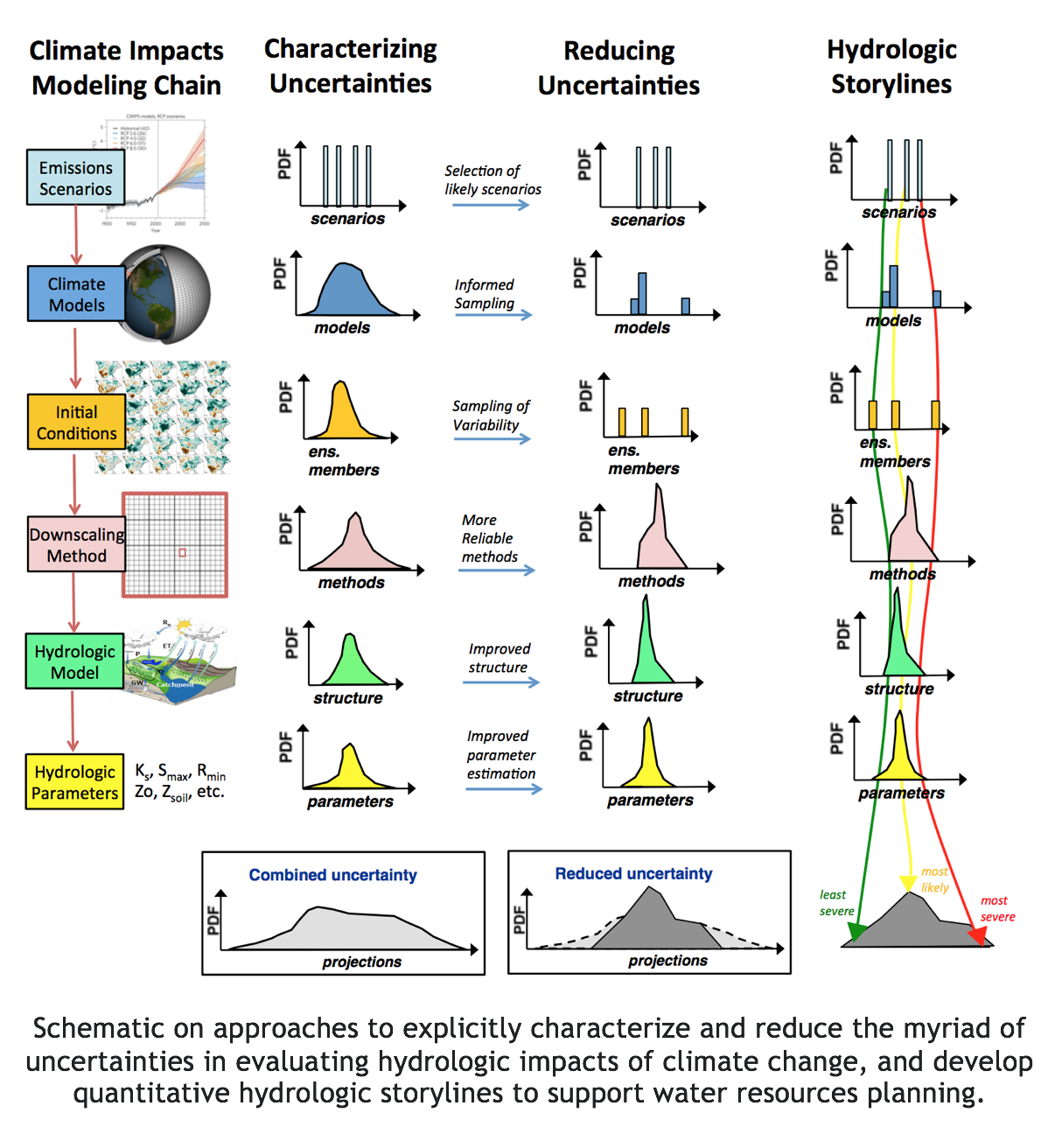To assess risks, it is essential to characterize and communicate the uncertainties in hydrologic projections. Each step in the climate impacts modeling chain (first column of the figure) has uncertainties. While several studies have sampled uncertainties by varying elements at each step (second column), they are typically limited by: (i) relying on small ensembles of models which are not independent, (ii) not explicitly accounting for model errors when selecting models and interpreting their results, and/or (iii) presenting results in a way that gives the impression that the uncertainty is fully sampled, when it is not. However, large ensembles, while important in revealing uncertainties, can be computationally impractical in applications, and thus require the development of innovative methods to assess climate impacts.
Scientists and engineers in RAL’s Hydrometeorological Applications Program at the National Center for Atmospheric Research are collaborating with the U.S. Army Corps of Engineers, the Bureau of Reclamation, and the University of Washington to develop quantitative hydrologic storylines of climate change impacts. The work entails systematically characterizing uncertainties across the suite of models used for climate impact assessments, evaluating model fidelity and culling models accordingly to reduce these uncertainties, and distilling hydrologic projections into a discrete set of quantitative hydrologic “storylines” that represent key features from the full range of future scenarios (illustrated in figure and described in more detail in Clark et al [2016]).
Development of methods that allow for more systematic and comprehensive sampling of uncertainties in hydrologic projections, specifically:
The modeling frameworks SUMMA [Clark et al., 2015a,b] and ICAR [Gutmann et al., 2016], which are cornerstones of this project, have been developed and are now operational, effectively allowing for large ensemble simulations of hydrologic and atmospheric processes (second column in figure).
New process-based diagnostics tools are being developed to enable robust model evaluation and weighting (third column in figure). Evaluation of model fidelity will use a wide range of methods, including quantifying and visualizing model similarity and evaluating models on both their output and ability to capture dominant climatic and hydrologic processes important in water resources planning [Addor et al., 2016].
These scientific advances provide opportunities to:
Continue to refine model evaluation criteria and determine under which conditions models could be downweighted or excluded. Clustering will be used to maximize model diversity and reduce computational costs by identifying redundancies.
Interact with the broader community to better define end-users needs and identify the specific decisions to be made in planning studies.
Develop an approach to build quantitative hydrologic “storylines” (fourth column in figure). This will provide the applications community with a manageable subset of future hydrologic scenarios for climate impacts assessments that reveal underlying model uncertainties and are tailored to their planning studies.

NCAR: Martyn Clark (PI), Ethan Gutmann (Co-PI), Andy Wood (Co-PI), Nans Addor, Naoki Mizukami, Andrew Newman, Joe Hamman, Julie Vano
University of Washington: Bart Nijssen
U.S. Army Corps of Engineers: Jeff Arnold
Bureau of Reclamation: Levi Brekke, Ken Nowak
Contact: Ethan Gutmann - gutmann@ucar.edu | Julie Vano - jvano@ucar.edu
U.S. Army Corps of Engineers, Bureau of Reclamation
Factsheets:
2-Pager (same info as this page)
Papers: